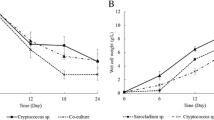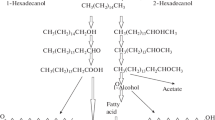Abstract
The effect of monorhamnolipid (monoRL) on the degradation of n-hexadecane by Candida tropicalis was investigated in this study. The concentration of hexadecane, cell growth, cell surface hydrophobicity (CSH), cell surface zeta potential (CSZP), and FT-IR spectra of cellular envelope were tested to determine the mechanisms. MonoRL at the initial concentrations of 11.4, 19, and 38 mg/l improved the degradation of hexadecane, and 19 mg/l was the best concentration. However, 114 mg/l monoRL suppressed the biodegradation probably because of the reduced bioavailability of hexadecane caused by the micelles. The presence of monoRL changed the cell surface properties, which was demonstrated by the increased CSH, the increased CSZP, and the changed FT-IR spectra of cellular envelope at 680 and 620 cm−1. The changes of cell surface properties may be a reason for the enhanced biodegradation of hexadecane by the yeast. The results indicate the potential application of monoRL in the bioremediation of hydrocarbons.






Similar content being viewed by others
References
Ahimou F, Jacques P, Deleu M (2000) Surfactin and iturin A effects on Bacillus subtilis surface hydrophobicity. Enzyme Microb Technol 27:749–754
Al-Tahhan RA, Sandrin TR, Bodour AA, Maier RM (2000) Rhamnolipid-induced removal of lipopolysaccharide from Pseudomonas aeruginosa: effect on cell surface properties and interaction with hydrophobic substrates. Appl Environ Microbiol 66(8):3262–3268
Busscher HJ, van de Belt-Gritter B, van der Mei HC (1995) Implications of microbial adhesion to hydrocarbons for evaluating cell surface hydrophobicity 1 Zeta potentials of hydrocarbon droplets. Colloids Sur B 5:111–116
Coimbra CD, Rufino RD, Luna JM, Sarubbo LA (2009) Studies of the cell surface properties of Candida species and relation to the production of biosurfactants for environmental applications. Curr Microbiol 25:245–251
Deng Y, Zhang Y, Hesham AE, Liu R, Yang M (2010) Cell surface properties of five polycyclic aromatic compound-degrading yeast strains. Appl Microbiol Biotechnol 86:1933–1939
Deschênes L, Lafrance P, Villeneuve JP, Samson R (1996) Adding sodium dodecyl sulfate and Pseudomonas aeruginosa UG2 biosurfactants inhibits polycyclic aromatic hydrocarbon degradation in a weathered creosote-contaminated soil. Appl Microbiol Biotechnol 46:638–646
Falatko DF, Novak JT (1992) Effects of biologically produced surfactants on the mobility and biodegradation of petroleum hydrocarbons. Water Environ Res 64:163–169
Geertsema-Doornbusch GI, van der Mei HC, Bushcher HJ (1993) Microbial cell surface hydrophobicity the involvement of electrostatic interactions in microbial adhesion to hydrocarbons (MATH). J Microbiol Methods 18:61–68
Hazen KC, Lay J-G, Hazen BW, Fu RC, Murthy S (1990) Partial biochemical characterization of cell surface hydrophobicity and hydrophilicity of Candida albicans. Infect Immun 58:3469–3476
Herman DC, Zhang Y, Miller RM (1997) Rhamnolipid (biosurfactant) effects on cell aggregation and biodegradation of residual hexadecane under saturated flow conditions. Appl Environ Microbiol 63:3622–3627
Hickey AM, Gordon L, Dobson ADW, Kelly CT, Doyle EM (2007) Effect of surfactants on fluoranthene degradation by Pseudomonas alcaligenes PA-10. Appl Microbiol Biotechnol 74:851–856
Hua Z, Chen J, Lun S, Wang X (2003) Influence of biosurfactants produced by Candida antarctica on surface properties of microorganism and biodegradation of n-alkanes. Water Res 37:4143–4150
Hua Z, Song R, Du G, Li H, Chen J (2007) Effects of EDTA and Tween60 on biodegradation of n-hexadecane with two strains of Pseudomonas aeruginosa. Biochem Eng J 36:66–71
Ijah UJJ (1998) Studies on relative capabilities of bacterial and yeast isolates from tropical soil in degrading crude oil. Waste Manage 18:293–299
Ishigami Y, Gama Y, Nagahora H, Yamaguchi M, Nakahara H, Kamata T (1987) The pH-sensitive conversion of molecular aggregates of rhamnolipid biosurfactant. Chem Lett 5:763–766
Ito S, Inoue S (1982) Sophorolipids from Torulopsis bombicola: possible relation to alkane uptake. Appl Environ Microbiol 43:1278–1283
Kaczorek E, Urbanowicz M, Olszanowski A (2010) The influence of surfactants on cell surface properties of Aeromonas hydrophila during diesel oil biodegradation. Colloids Sur B 81:363–368
Liu Z, Zeng G, Wang J, Zhong H, Ding Y, Yuan X (2010) Effects of monorhamnolipid and Tween 80 on the degradation of phenol by Candida tropicalis. Process Biochem 45:805–809
Mata-Sandoval JC, Karns J, Torrents A (2001) Influence of rhamnolipids and Triton X-100 on the biodegradation of three pesticides in aqueous phase and soil slurries. J Agric Food Chem 49:3296–3303
Mozes N, Léonard AJ, Rouxhet PG (1988) On the relations between the elemental surface composition of yeasts and bacteria and their charge and hydrophobicity. Biochim Biophys Acta 945:324–334
Noordman WH, Janssen DB (2002) Rhamnolipid stimulates uptake of hydrophobic compounds by Pseudomonas aeruginosa. Appl Environ Microbiol 68:4502–4508
Oberbremer A, Miiller-Hurtig R, Wagner F (1990) Effect of the addition of microbial surfactants on hydrocarbon degradation in a soil population in a stirred reactor. Appl Microbiol Biotechnol 32:485–493
Providenti MA, Flemming CA, Lee H, Trevors JT (1995) Effect of addition of rhamnolipid biosurfactants or rhamnolipid-producing Pseudomonas aeruginosa on phenanthrene mineralization in soil slurries. FEMS Microbiol Ecol 17:15–26
Ron EZ, Rosenberg E (2002) Biosurfactants and oil bioremediation. Curr Opin Biotechnol 13:249–252
van Loosdrecht MCM, Lyklema J, Norde W, Schraa G, Zehnder AJB (1987) Electrophoretic mobility and hydrophobicity as a measure to predict the initial steps of bacterial adhesion. Appl Environ Microbiol 53:1898–1901
Whang L, Liu PG, Ma C, Cheng S (2009) Application of rhamnolipid and surfactin for enhanced diesel biodegradation—effects of pH and ammonium addition. J Hazard Mater 164:1045–1050
Wong JWC, Fang M, Zhao Z, Xing B (2004) Effect of surfactants on solubilization and degradation of phenanthrene under thermophilic conditions. J Environ Qual 33:2015–2025
Zeng G, Fu H, Zhong H, Yuan X, Fu M, Wang W, Huang G (2007) Co-degradation with glucose of four surfactants, CTAB, Triton X-100, SDS and rhamnolipid, in liquid culture media and compost matrix. Biodegradation 18:303–310
Zhang Y, Miller RM (1992) Enhanced octadecane dispersion and biodegradation by a Pseudomonas rhamnolipid surfactant (biosurfactant). Appl Environ Microbiol 58:3276–3282
Zhang Y, Miller RM (1994) Effect of a Pseudomonas rhamnolipid biosurfactant on cell hydrophobicity and biodegradation of octadecane. Appl Environ Microbiol 60:2101–2106
Zhang Y, Miller RM (1995) Effect of rhamnolipid (biosurfactant) structure on solubilization and biodegradation of n-alkanes. Appl Environ Microbiol 61:2247–2251
Zhang Y, Maier WJ, Miller RM (1997) Effect of rhamnolipid on the dissolution, bioavailability, and biodegradation of phenanthrene. Environ Sci Technol 31:2211–2217
Zhong H, Zeng G, Yuan X, Fu H, Huang G, Ren F (2007) Adsorption of dirhamnolipid on four microorganisms and the effect on cell surface hydrophobicity. Appl Microbiol Biotechnol 77(2):447–455
Zhong H, Zeng G, Liu J, Xu X, Yuan X, Fu H, Huang G, Liu Z, Ding Y (2008) Adsorption of monorhamnolipid and dirhamnolipid on two Pseudomonas aeruginosa strains and the effect on cell surface hydrophobicity. Appl Microbiol Biotechnol 79:671–677
Acknowledgments
The study was financially supported by the Program for Changjiang Scholars and Innovative Research Team in University (IRT0719), the National Natural Science Foundation of China (50908081, 50978088, 51039001), the Hunan Key Scientific Research Project (2009FJ1010), the Hunan Provincial Natural Science Foundation of China(10JJ7005), the British Columbia Innovation Council (ICSD-2007-Li-J), the Xiamen Science & Technology Planning Project Fund (3502Z20093040), and the Hunan University Graduate Education Innovation Project (531107011019).
Author information
Authors and Affiliations
Corresponding author
Rights and permissions
About this article
Cite this article
Zeng, G., Liu, Z., Zhong, H. et al. Effect of monorhamnolipid on the degradation of n-hexadecane by Candida tropicalis and the association with cell surface properties. Appl Microbiol Biotechnol 90, 1155–1161 (2011). https://doi.org/10.1007/s00253-011-3125-6
Received:
Revised:
Accepted:
Published:
Issue Date:
DOI: https://doi.org/10.1007/s00253-011-3125-6




